Cubelock
Cubelock is a brand new Warlock Archetype that has popped up due to the recent expansion, and more specifically, the release of many warlock specific cards that help compliment the neutral Carnivorous Cube, very well. While this deck idea may have originated in Standard, it was quickly adapted to the wild format by CapilanoHS and myself. The core idea of the deck gets exponentially stronger with the additions of Voidcallers and Mal’Ganis.
The deck plays a control-combo style, similar to the Handlock days of old. Try to stay alive and draw cards for the first couple of turns until you have the resources to combo cards and swing the board back into your favor. However, instead of the 4/10 Twilight Drakes and 8/8 Giants that get taunted up of old, you have Voidcallers and Possessed Lackeys that are being combo-d with Carnivorous Cube and Dark Pact to summon high cost, extremely powerful demons from your hand or deck.
The archetype is brand new so decklists, tech choices, meta reads, are all changing. While there is no refined list at the moment, for the sake of this guide, I will use the decklist that I am currently laddering with on NA legend ladder.
Cubelock Card Choices
Like I mentioned earlier, since this archetype is brand new and there are many versions out there, I want to go through and explain why every card has it’s place in the decklist. The current meta has many other versions of Cubelock running around as well as many OTK decks trying to take advantage of favorable matchups against Cubelock and Reno Priest. This current iteration lowers some of the consistency against aggro matchups in order to increase percentages in the mirror and against Combo decks.
Core Cards
Dark Pact – Cheap activator for Voidcaller and Possessed Lackey allowing you to combo out a demon as early as turn 4. Also provides some much needed heal for a deck that usually gets beaten down in the early game.
Kobold Librarian – 1 mana life tap to your combo piece and a buff to the spellstone. Great card overall
Darkbomb – 2 mana 3 damage removal spell, necessary in this meta. Can also be used for reach against control decks.
Defile – Best removal spell available to Warlocks hands down. Single handedly clears most paladin boards
Hellfire – Another great warlock removal spell. The mirrored AOE doesn’t matter as you don’t have a board at that point. The buff to a spellstone is just an added bonus.
Lesser Amethyst Spellstone – This card has grown on me the more I’ve played it in this deck. Removal + healing that is decent even at the base level which makes it playable even with only 4 potential upgrades. Any upgrade makes this card that much better
Voidcaller – The reason that this deck exists in wild. Voidcaller allows you to cheat out those expensive demons from your hand, similar to the role that Skull of Manari plays in Standard. The reason you should play this instead of the Skull is that this is not only 1 mana cheaper, but it’s in the form of a 3 / 4 body that can help contest board as well.
Carnivorous Cube – The namesake of the deck for good reason. Used to activate the Voidcallers and Lackey; however, the real power of this card comes in eating a Doomguard or a Mal’Ganis and using Dark Pact on the Cube to multiply the amount of powerful demons
Doomguard – I think only one Doomguard is core to this list since the OTK that is prevalent in standard is not the only way that this deck can win in Wild. 2 Doomguards can clog up your hand and reduce the chance of pulling Voidlord or Mal’Ganis off your Lackey in the Aggro matchups
Possessed Lackey – While the 2/2 body is weak on its own, the ability to cheat out a Void Lord from your deck against aggro when played in tandem with Dark Pact or removal spell is insane and makes this worth playing.
Mal'Ganis – Absolute powerhouse of a card that makes every other demon so much better, with the added bonus of making your hero immune. One of the most important cards in the deck
Voidlord – Instantly win against aggro decks the moment you can pull one off a Voidcaller or a Lackey. Becomes a threat on its own against control decks when you combo with Mal’Ganis.
Bloodreaver Gul'dan – Another great card that gets much better when you can bring back 2-3 copies of Mal’Ganis or Doomguards from the Cube. Great finishing card
Flex Cards
Prince Taldaram – A three mana Faceless Manipulator for your cubes, your Voidlords, or even opponent’s cubes, Mal’ganis or even a 3/3 Patches against aggro to help you control the board
Spellbreaker – A tech card that I’ve fallen in love with in this meta. Silence their Voidcallers, Possessed Lackey’s or Cubes to prevent the tempo gain. This helps ensure that you can combo first and put the pressure on them
Spiritsinger Umbra – Allows for insane combos against control decks when played in tandem with a Voidcaller or Lackey or even a Sylvanas (if you’re running her)
Loatheb – Another great card for Tempo in the mirrors as well as preventing a board wipe. However, the real reason this card is in the deck is to give you some semblance of a chance against the combo OTK decks that have risen in the meta. A well-timed Loatheb will give you a window to kill them before they can kill you.
Emperor Thaurissan – A general great card for Warlock Decks due to the nature of generally having a large hand size allowing you to cheat out a 9 mana demon a turn earlier or a 10 mana finisher out on turn 9. A note that an Emperor tick can allow for a Sylvanus, Carnivorous Cube, Dark Pact combo which is just crippling for decks like Big Priest or other control decks that are present in the current Wild Metagame
Sylvanas Windrunner – A card that is great in tempo or control matchups that can get even better when played in combo with cards like Cube or Umbra
N'Zoth, The Corruptor – Just another finisher against control decks that can get so much value if you still have demons in your deck or hand. Brings back 4 / 6 cubes that are strong bodies on their own or can bring back a Sylvanus or 2 to help against other temp or control decks.
Mulligan Strategy
The mulligan section is split into two parts – against fast decks and against slow decks. Fast decks are generally the aggro decks (Aggro Paladin, Pirate Warrior) or high tempo midrange decks (Tempo Rogue, Zoolock). Slow decks are the slower midrange, control, and combo decks. It should be noted that these are general mulligan strategies and then can differ depending on your decklist and specific matchups.
v.s. Fast Decks
High Priority (Keep every time)
Kobold Librarian – Great turn 1 play even against aggro decks. Turn 1 cycle that even if it gets eaten by Patches, it’s 1 less damage coming at your face. Also upgrades spellstone if it happens to be in your hand
Defile– Best clear hands down against almost every aggro deck. Single handedly can win you games against Aggro Paladin
Hellfire – Another clear that you need to just stall the game out until you can get the Voidcaller or Lackey into Voidlord down. Upgrade to the spellstone is just an additional upside
Darkbomb – 2 mana, 3 damage removal spell that takes out Jugglers, Ship’s Cannon’s and other early game cards that can snowball out of control if not dealt with
Lower Priority (Keep only if certain conditions are met)
Lesser Amethyst Spellstone – If you have other removal spells, you can keep this to help deal with an early Corridor Creeper
Voidcaller – I would only keep this against aggro if the rest of the hand is already removal spells. Otherwise I would toss to ensure that you get an AOE card.
Voidlord – Only keep this in your opening hand if you have a Voidcaller AND 2 other removal spells. This almost ensures that you can get the Voidlord down on turn 5 to win you the game. You have to get there first though, which is why you only keep if you have the other removal spells
v.s. Slow Decks
High Priority (Keep every time)
Voidcaller – You want this card on turn 4 or turn 3 every game against control decks. Having this early helps cheat out demons which wins you games. Getting this early also prevents getting this off lackey or other voidcallers.
Possessed Lackey – Same deal as Voidcaller, helps with the whole game plan of cheating out the big demons
Kobold Librarian – Turn 1 play that cycles towards your good cards that can end up doing up a lot of damage if unchecked
Lower Priority (Keep only if certain conditions are met)
Carnivorous Cube – Keep if you have a Voidcaller or Lackey. Can be used to activate them at the worse, but can be used on a Doomguard or Mal’Ganis that gets pulled out from the aforementioned 2
Doomguard/Mal'Ganis – I would keep these ONLY if you have a voidcaller in our hand already. This allows you to guarantee a great pull out of the Voidcaller on turn 4
Cubelock Play Strategy
Cubelock plays similar to the Handlock decks of hold. Hold the board at bay for the first few turns until you can swing the board back massively into your favor.
v.s. Aggro
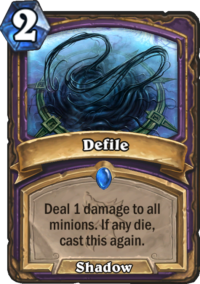 The first few turns against Aggro are crucial. You must find at LEAST one early game removal spells, preferably Defile. This allows you to keep the board under control until you can play the Voidcallers or Lackey. The goal against aggro is to take as little damage as possible in the first few turns and ultimately pull out a Voidlord or Mal’Ganis from your hand or deck.
The first few turns against Aggro are crucial. You must find at LEAST one early game removal spells, preferably Defile. This allows you to keep the board under control until you can play the Voidcallers or Lackey. The goal against aggro is to take as little damage as possible in the first few turns and ultimately pull out a Voidlord or Mal’Ganis from your hand or deck.
Generally, if you can get through the early game, the midgame turns the game in your favor. The general game plan against aggro decks is to get out an early Voidlord or Mal’Ganis and using them to buy a few turns by having them commit resources into the big beefy minions while you have time to find more big threats, ways to duplicate the threats already on board.
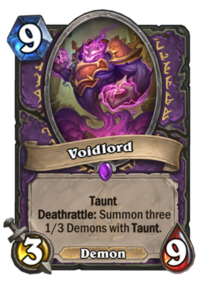
Do not be afraid to tap to ensure that you have big demons in your hand to pull with Voidcallers. Many decks are teching in Spellbreaker to try and deal with Voidlords. Because of this, you cannot be content once you get a big minion down. You need to find a cube + dark pact or another big demon to make sure that you can stabilize. Against aggro decks, do not be afraid to Cube a Voidcaller or Lackey if it’s the best way for you to activate them.
Generally, if you get to turn 10, you should already be in a pretty good position, but dropping down Bloodreaver Gul’dan just seals the game and locks out your opponent by bringing back the big demons in addition to the lifesteal hero power.
v.s. Control
Against control decks, specifically Reno Priest (the gold standard of Wild Power Decks), the challenge is balancing the line between pressuring the opponent and overextending on the board.
In the first few turns, you’ll be allowed to freely tap and cycle librarians to make sure that you’re able to find your Voidcallers, Lackeys, and some follow up, including Carnivorous Cubes and a big demon to pull off the Voidcaller.
An interesting line is that on turn 3, if you are going to play a Kobold Librarian, make sure that you are tapping first before the Librarian to increase the chances of you having a Spellstone that gets buffed.
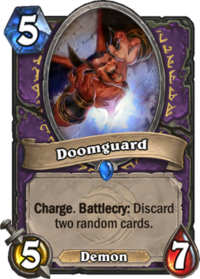
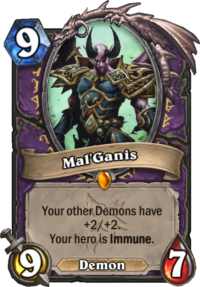
In control matchups, you really want to ‘Cube’ 3 targets, Doomguard, Mal’Ganis, or Sylvanus. As opposed to the Aggro matchup, where cubing a Voidlord is almost a sure win, multiple Voidlords against control means multiple Voidwalker’s. These minions don’t put enough pressure on control decks and too many Voidwalkers dilutes your Bloodreaver Gul’Dan pool of resurrected demons.
In control matchups, look to copy as many Mal’Ganis or Doomguards as possible. Make sure you keep an eye out for sneaky lethals with the damage that can rapidly add up with these cards.
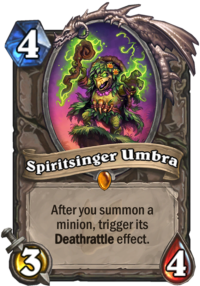 Control matchups is also where Spiritsinger Umbra shines. Umbra allows you for some insane combos with Voidcaller that will pull out a Voidlord and immediately procs that deathrattle, Voidcaller into Voidcaller into Mal’Ganis, or Umbra + Cube on a big demon to immediately get two more demons. Umbra also works well with Sylvanus as a pseudo Mind Control. Control decks are where this deck is absolutely insane. Just be careful against Priest because of Psychic Scream. This is why you can’t go all in on a board unless it specifically sets up lethal next turn or you can make the read that he doesn’t have it in his hand. Against Priest, try to proc your Voidcallers and Cube’s as early as possible to prevent silence or Psychic Scream. If your opponent has not played a Potion of Madness or a silence yet, do NOT play your Lackey without a way to kill it immediately with a Dark Pact, Darkbomb, Cube, or Hellfire. Priest opponents love to just steal your lackey and kill it off and laugh at your waste of 5 mana.
Control matchups is also where Spiritsinger Umbra shines. Umbra allows you for some insane combos with Voidcaller that will pull out a Voidlord and immediately procs that deathrattle, Voidcaller into Voidcaller into Mal’Ganis, or Umbra + Cube on a big demon to immediately get two more demons. Umbra also works well with Sylvanus as a pseudo Mind Control. Control decks are where this deck is absolutely insane. Just be careful against Priest because of Psychic Scream. This is why you can’t go all in on a board unless it specifically sets up lethal next turn or you can make the read that he doesn’t have it in his hand. Against Priest, try to proc your Voidcallers and Cube’s as early as possible to prevent silence or Psychic Scream. If your opponent has not played a Potion of Madness or a silence yet, do NOT play your Lackey without a way to kill it immediately with a Dark Pact, Darkbomb, Cube, or Hellfire. Priest opponents love to just steal your lackey and kill it off and laugh at your waste of 5 mana.
Bloodreaver Gul’dan and N’Zoth the Corruptor can often close out games that go long by bringing back more layers of threats that require almost immediate answers. Timing of these 10-drops are crucial. I generally lead with N’Zoth the Corruptor to pull whatever demons are left in the deck by bringing back Lackeys and Voidcallers and the Cubes and Sylvanus are threats on their own. You usually can bait out the Nether or a Psychic Scream on the N’Zoth board which allows your board generated by Bloodreaver Gul’Dan to stick and deal massive damage.
Substitutions
Spiritsinger Umbra/Prince Taldaram – If you do not have Umbra or Taldaram, I don’t blame you. This is the first time they have ever been viable. I would put in a Faceless Manipulator or a second Doomguard in the place of Prince Taldaram. I would put either of those 2 previous options or maybe a Baron Rivendare for the Spiritsinger Umbra.
Sylvanas Windrunner/Emperor Thaurissan – These cards are great against control decks. If you want to shore up your early game or you just don’t have these expensive legendaries, you can substitute in two Mistress of Mixtures or Demonwraths depending on what you want to specifically tech against.
Loatheb/Spellbreaker – These are both tech cards for my local meta. If these are not performing for you or they just don’t line up with your local meta, feel free to take these out. I personally would put back in Mortal Coils to help with aggro, cycle in other matchups, and even set up some insane defiles.
About Me – I’m a regular Wild Legend Player and high legend finisher. I love messing with new and unrefined decks. You can find me on twitter and I stream pretty regularly on Twitch.





















/rating_1_half.png)
/rating_2_off.png)
Amazing deck, great guide, tyvm.
You forgot the weapon?
The weapon is not needed, and I would go as far to say, bad in wild. The Voidcallers are just straight up better and do the same thing
Ah yeah fair enough, I have no experience in Wild just felt that the weapon is essential in Standard 😛
only one Doomguard ?
I have found 2 to often be clunky and lowers the chance that you pull the Voidlords from your Lackey against aggro
Thank you very much for the guide!!